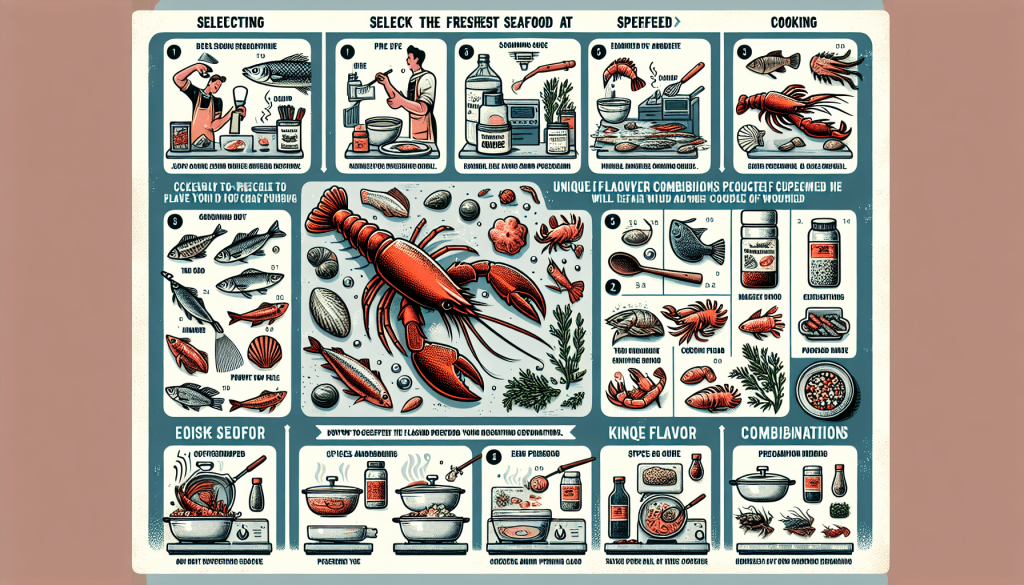If you’re a seafood lover or simply looking to expand your culinary skills, this article is for you. We’ve gathered the most popular cooking tips for cooking seafood, allowing you to prepare delicious seafood dishes with confidence. From selecting the freshest seafood to mastering different cooking techniques, we’ve got you covered. Whether you prefer grilled fish, succulent shrimp, or flaky salmon, these tips will help you elevate your seafood cooking game to the next level. So grab your apron and get ready to create mouthwatering seafood dishes that will impress your friends and family.
Choosing Fresh Seafood
When it comes to choosing fresh seafood, there are a few key factors to look out for. One of the first things you should check is the eyes of the fish. Fresh seafood should have clear, shiny eyes. Cloudy or dull eyes can indicate that the fish is not as fresh. Another important factor to consider is the texture of the fish. When you press on the flesh, it should be firm and springy. If the flesh feels mushy or soft, it may not be the best choice. Lastly, be sure to avoid any strong fishy odor. Fresh seafood should have a clean and mild scent. If there is a strong fishy smell, it could be a sign that the seafood has started to spoil. By keeping these factors in mind, you can ensure that you are choosing the freshest seafood for your meal.
Properly Storing Seafood
After you have carefully selected your seafood, it is crucial to properly store it to maintain its freshness. As soon as you bring your seafood home, make sure to refrigerate it immediately. This will help to slow down any bacterial growth and keep the seafood fresh for longer. Additionally, it is important to store the seafood in the coldest part of the fridge, usually the bottom shelf. This is because cold air sinks, so the lower you place the seafood, the better the chances of keeping it at the ideal temperature. To further protect your seafood from any potential contaminants, store it in an airtight container. This will help to prevent any odors or flavors from other foods in your fridge from seeping into the seafood. By following these storage guidelines, you can ensure that your seafood remains fresh and safe to eat.

Preparing Seafood
Once you are ready to cook your seafood, it is essential to properly prepare it. If you are using frozen seafood, it is recommended to thaw it slowly in the refrigerator. This gradual thawing process allows the seafood to retain its moisture and texture. Before cooking, be sure to clean and rinse the seafood thoroughly. This helps to remove any dirt or impurities that may be present. Depending on the type of seafood you are working with, you may also need to remove scales, bones, or shells. Take your time to carefully clean and prepare the seafood before moving on to the cooking process. By taking these steps, you can ensure that your seafood is clean and ready to be cooked.
Marinating Seafood
Marinating seafood can be a great way to infuse it with flavor and tenderize it. When selecting a marinade, opt for acidic options such as lemon juice or vinegar. These acids help to break down proteins and make the seafood more tender. It is important to marinate the seafood in the refrigerator to prevent any bacterial growth. The recommended marinating time can vary depending on the type of seafood, so be sure to check a reliable recipe or guideline. Avoid marinating seafood for too long, as it can become mushy and lose its texture. By using acidic marinades and adhering to proper marinating times, you can enhance the flavor and texture of your seafood dishes.

Grilling Seafood
Grilling seafood can bring out its natural flavors and create a delicious charred exterior. To start, preheat your grill to high heat. This ensures that the seafood cooks quickly and evenly. Before placing the seafood on the grill, it is important to brush it with oil to prevent sticking. This also adds a subtle layer of flavor. When grilling seafood, it is recommended to cook it over direct heat for a few minutes per side. This will result in a nicely caramelized exterior while keeping the interior moist and flavorful. By following these grilling tips, you can create succulent and smoky seafood dishes.
Pan-Frying Seafood
Pan-frying is a popular cooking method for seafood as it creates a crispy exterior while keeping the inside tender and moist. Start by heating oil in a skillet over medium-high heat. You want the oil to be hot enough to sizzle when the seafood is added. Before frying, dredge the seafood in flour or breadcrumbs. This helps to create a golden brown and crispy crust. Cook the seafood until it is evenly browned on both sides and reaches a safe internal temperature. The exact cooking time will depend on the thickness and type of seafood you are using. By following these pan-frying tips, you can achieve perfectly crispy and flavorful seafood dishes.
Baking Seafood
Baking seafood is a versatile and convenient cooking method that allows the flavors to meld together while preserving the natural moisture. To start, preheat your oven to the required temperature stated in your recipe. Place the seafood on a baking sheet lined with parchment paper. This prevents sticking and makes for easier cleanup. Cook the seafood until it is opaque and flakes easily with a fork. The exact cooking time will vary depending on the type and thickness of the seafood. It is important to monitor the cooking process closely to avoid overcooking and drying out the seafood. By following these baking tips, you can create delicious and tender seafood dishes in the oven.
Steaming Seafood
Steaming seafood is a gentle cooking method that helps to preserve its delicate flavors and textures. To begin, bring water to a boil in a pot or steamer. Place the seafood in a steamer basket, ensuring that it is elevated above the water. This allows the steam to cook the seafood without directly submerging it in water. Steam the seafood for the recommended cooking time, which will vary depending on the type and size of the seafood. It is important to avoid overcooking, as this can result in a rubbery texture. By steaming seafood, you can create tender and moist dishes that are full of natural flavors.
Poaching Seafood
Poaching is a gentle and flavorful cooking technique that involves simmering the seafood in a liquid such as broth or wine. To begin, bring a poaching liquid to a simmer in a wide pot or saucepan. The liquid should be flavorful, such as a fish stock or a mixture of water and aromatic herbs and spices. Add the seafood to the simmering liquid and cook until it is firm and opaque. The cooking time will vary depending on the size and thickness of the seafood. Once cooked, remove the seafood from the liquid and serve it with the poaching liquid as a sauce. Poaching seafood is a great way to infuse it with delicate flavors and create a moist and tender result.
Serving Seafood
When it comes to serving seafood, there are a few things you can do to enhance the overall dining experience. Garnishing the seafood with fresh herbs or lemon wedges adds a touch of freshness and brightness. It can also enhance the flavors of the dish. Additionally, serving seafood with a dipping sauce or aioli can provide an extra layer of flavor. Some popular options include tartar sauce, cocktail sauce, or garlic aioli. Lastly, pairing seafood with complementary sides can elevate the meal. Roasted vegetables, such as asparagus or potatoes, bring a delicious contrast to the seafood. Risotto or a fresh salad can also be great accompaniments. By considering these serving suggestions, you can create a complete and enjoyable seafood dining experience.
